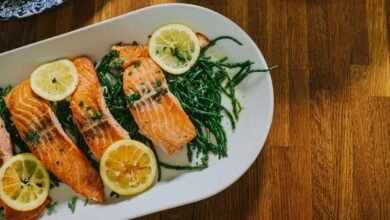7 Easy Ways to Make Your Recipes More Nutritious, According to A Dietitian

Whether you are a novice in the kitchen or an experienced home cook, you may be looking for ways to make your recipes more nutritious. By incorporating simple adjustments, it’s easy to transform your favorite dishes into nourishing meals that support your well-being and promote healthier habits. Here a registered dietitian provides tips, cooking techniques, and strategies to help you enhance the nutritional value of your homemade recipes without sacrificing flavor or enjoyment.
Understanding Nutritional Basics
Putting together a nutritious meal is simple with a few basic components. First are the macronutrients—protein, carbohydrates, and fats. These nutrients make up the majority of our diets and are important to incorporate at every meal. Next are the micronutrients, which are vitamins and minerals. Here is what you need to know.
Macronutrients
Protein is made up of amino acids, which are the building blocks of organs, bones, tendons, ligaments, and skin in your body. Protein is important for repairing the damage done to these body parts throughout the day. Your protein needs vary based on a number of factors, including age, activity level, and health conditions. Food sources of protein include meat, poultry, fish, eggs, dairy, edamame, tofu, tempeh, and legumes.
Carbohydrates are the brain and body’s preferred source of fuel. All carbohydrates break down during digestion into sugar that then is transported to your cells to be used as energy. Certain carbohydrate sources are also a good source of fiber, which is important for digestive health, heart health, and helping you feel fuller for longer. Carbohydrates are also a good source of B vitamins, which is crucial for the biological process to make energy. Food sources of carbohydrates include bread, pasta, rice, other grains, potatoes, sweet potatoes, and fruit. Dairy and legumes also contain some carbohydrates.
Fats are the third macronutrient and play important roles in cushioning internal organs, keeping you full and satisfied, absorbing fat-soluble vitamins, and producing hormones. Unsaturated fats such as avocado, nuts, seeds, olive oil, and omega-3 fatty acids found in fatty fish, are important for heart health and decreasing inflammation.
Micronutrients
Micronutrients are trace elements and vitamins that are essential for human metabolism. Vitamins are broken down into water-soluble and fat-soluble, which include vitamin C, B vitamins and vitamins A, D, E, and K, respectively. Minerals include iron, zinc, calcium, selenium, copper, magnesium, and more. These nutrients are primarily found in fruits and vegetables, though other macronutrients contain micronutrients as well.
Incorporating enough macro- and micronutrients into your meals and snacks contributes to the overall nutrient density of your diet. Nutrient-dense foods are high in nutrients and contain vitamins, minerals, lean proteins, healthy fats, and complex carbohydrates. The combination of these nutrients ensures you feel full and satisfied and get all of the components that you need to maintain a healthy lifestyle.
Tips for Boosting the Nutrition of Your Go-To Meals and Favorite Recipes
Here are various actionable, dietitian-recommended tips to make your favorite recipes and go-to meal prep items more nutritious. Choose one or all to focus on, and you’ll be sure to increase the nutrient density of your diet.
Incorporate Whole Foods
When cooking at home, it is preferable to use whole, unprocessed ingredients. These foods are minimally processed and therefore maintain the integrity of their nutrients. Using whole foods helps to maximize the nutrient density of your recipes. Whole foods are those you buy from the grocery store or farmers market that are in their most natural form as possible. Some of these foods include fruits, vegetables, meat, poultry, fish, and whole grains.
Incorporate more fruits and vegetables by making fresh salads, roasting them in the oven, or chopping them up to have them readily available as snacks. Lean proteins can be simply broiled or roasted for an easy lunch and dinner. Try using beans as an easy, unprocessed plant-based protein. Boil some quinoa, rice, or farro, or roast potatoes for a carbohydrate-rich side dish.
Choose Healthy Cooking Methods
How you cook your recipes is key to maintaining nutrient density. Certain cooking methods, such as steaming, baking, grilling, and sautéing help to retain nutrients and reduce the need to use extra fats and oils. Baking, roasting, and grilling are dry heat cooking methods that promote very little nutrient loss.
Grilling is another dry heat method that imparts a delicious flavor to proteins and vegetables. Grilling also does a good job of maintaining nutrients, however, B vitamins may also be reduced in the meat drippings.
Stir-frying and sautéing are healthy ways to prepare food with a small amount of fat from oil or butter in a pan over medium heat. Cooking times are often shorter, which prevents the loss of vitamins. Plus, the addition of fat increases the absorption of fat-soluble vitamins from vegetables. Steaming is one of the best methods when it comes to preserving nutrients, however, a downside is that food often tastes more bland when steamed.
To maximize nutrients in your cooked foods, try using dry heat methods (baking, roasting, or grilling are excellent examples). When cooking meat, poultry, and fish, use the shortest cooking time possible for safe consumption to maintain the integrity of the B vitamins, and cook vegetables for a few minutes when possible. Additionally, use lower and medium heat methods to cook your food to maintain nutrients as well as minimize the degradation of any oil used.
Enhance Flavor with Herbs and Spices
You can add tons of flavor to your food with herbs and spices without added fat, salt, and sugar. Not only do herbs and spices reduce the need for less nutritious flavorings, but they add health benefits as well. Here are just a few of the many herbs and spices you can use to add zest and flavor to your recipes:
- Basil: Basil is a fragrant green herb most commonly known for its role in Italian and Thai cuisine. It is high in antioxidants and anti-inflammatory compounds.
- Cilantro: This herbal plant has been found to help reduce the risk of heart disease, diabetes, and supports healthy hair and skin.
- Garlic: A common seasoning in many cuisines, garlic is known for a number of important health benefits. Garlic is high in vitamin B6, vitamin C, and fiber and it is known to protect against the common cold and flu as well as decrease blood pressure and improve cholesterol levels.
- Ginger: Ginger is a sweet and spicy root with anti-inflammatory and anti-nausea properties. It can also aid digestion and help fight the flu and the common cold.
- Turmeric: Turmeric is the spice that gives curry its bright yellow color. It is known for its many medicinal properties including anti-inflammatory and powerful antioxidant effects. Turmeric may also lower the risk of heart disease and protect against Alzheimer’s disease.
- Cinnamon: This sweet spice is rich in antioxidants, reduces inflammation, and plays an important role in blood sugar control.
Make Smart Ingredient Swaps
While there is certainly a time and a place for all foods, if you’re looking to lighten up your recipes, there are some smart swaps you can make.
- If you like to bake, you can swap out butter for avocado, banana, or apple sauce in many cookie, cake, and quick bread recipes. Generally, you can swap these out in a 1:1 ratio, so if a recipe calls for 1/2 cup of butter, you can replace it with 1/2 cup of applesauce.
- You can also use whole wheat flour in place of refined flour to increase the B vitamins and fiber in your baking.
- For recipes that call for mayonnaise or sour cream, try Greek yogurt instead for more calcium and protein.
- Instead of added sugar or maple syrup for sweetness, try warm and sweet spices like cinnamon, nutmeg, and cloves.
Add Nutritional Boosters
When thinking about making your meals more nutritious, be sure to think about what you can add rather than take away. Incorporating nutritional boosters can do just that—add nutrition to your recipes without sacrificing taste.
- Adding seeds, such as chia seeds, hemp seeds, and flaxseeds, helps boost protein, fiber, and healthy fats in oatmeal, yogurt, smoothies, and even salads.
- Sprinkle nutritional yeast on kale chips, roasted cauliflower, and popcorn for extra vitamin B12 and protein.
- Add collagen peptide powder to smoothies, oatmeal, or baked good to increase protein and the amino acid, glycine, which provides strength for your muscles, skin, bones, and ligaments.
Practice Portion Control and Balanced Plates
Not only do the foods you put on your plate matter, but portion sizes and balanced plates help to boost your nutrition as well. To make a balanced meal, think about including a protein, carbohydrate, healthy fat, and color from fruits or vegetables.
As a general guide, you can think about covering one-quarter of your plate with protein, one-quarter with carbohydrates, and half with fruits or vegetables. Keep in mind that this is a general guideline, so you may need more or less of certain food groups based on your individual health goals. Consider speaking with a registered dietitian for guidance and advice on your individual nutrition needs.
Engage in Mindful Eating and Prioritize Enjoyment
Practicing mindful eating helps increase your awareness of hunger and fullness signals, making you better able to listen to your body and stop eating when you are full. It can also help with better digestion and healthier food choices.
Food is for nourishment, but it is also for enjoyment and pleasure. Using all of your five senses to savor your food increases the enjoyment and satisfaction factor of your meals.
As you can see, there are numerous strategies for boosting the nutrition of your recipes. Everything from changing your cooking method, making a simple swap, and adding more herbs and spices can help increase the nutrition of your meals.
You don’t need to make all of these changes at one time. Making small changes and mindful choices can significantly impact the nutritional value of your meals. Experiment with what makes sense for your lifestyle now, explore new ingredients, and gradually incorporate these strategies into your cooking routine. Nutritious meals can also be flavorful, delicious, and enjoyable, supporting your overall health and well-being.




